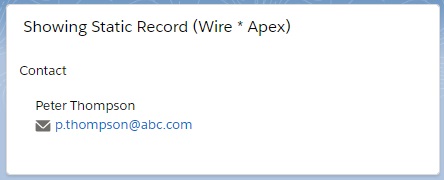Now, we will see how to get Salesforce data as static way using Apex.
We have built a LWC named “showWireApexStaticContact“.
Step 1: We have created an Apex Class named “LWC_ContactController” by which we will send the Contact record to Lightning Web Component. We can use the same class.
LWC_ContactController.cls
public with sharing class LWC_ContactController{
@AuraEnabled(cacheable=true)
public static Contact getStaticContact(){
return [SELECT Id, Name, Title, Phone, Email FROM Contact LIMIT 1];
}
}
getStaticContact() method returns the Contact Record.
Step 2: As per previous examples, we need to update the “showWireApexStaticContact.js-meta.xml” file to set the visibility in Lightning App Builder.
showWireApexStaticContact.js-meta.xml
<?xml version="1.0" encoding="UTF-8"?>
<LightningComponentBundle xmlns="http://soap.sforce.com/2006/04/metadata" fqn="showWireApexStaticContact">
<apiVersion>45.0</apiVersion>
<isExposed>true</isExposed>
<targets>
<target>lightning__AppPage</target>
<target>lightning__RecordPage</target>
<target>lightning__HomePage</target>
</targets>
</LightningComponentBundle>
Step 3: Need to write the respective HTML file.
showWireApexStaticContact.html
<template>
<lightning-card title="Showing Static Record (Wire * Apex)">
<lightning-layout>
<lightning-layout-item flexibility="auto" padding="around-small">
Contact
<template if:true={contactObj.data}>
<div class="slds-m-around_medium">
<p>{name}</p>
<p>{phone}</p>
<p><lightning-formatted-email value={email}></lightning-formatted-email></p>
</div>
</template>
<template if:true={contactObj.error}>
{contactObj.error}>
</template>
</lightning-layout-item>
</lightning-layout>
</lightning-card>
</template>
Step 4: Now, we need to work on the JS file.
showWireApexStaticContact.js
import { LightningElement, wire } from 'lwc';
import { getSObjectValue } from '@salesforce/apex';
import getStaticContact from '@salesforce/apex/LWC_ContactController.getStaticContact';
import CONTACT_NAME_FIELD from '@salesforce/schema/Contact.Name';
import CONTACT_PHONE_FIELD from '@salesforce/schema/Contact.Phone';
import CONTACT_EMAIL_FIELD from '@salesforce/schema/Contact.Email';
export default class ShowStaticContact extends LightningElement {
@wire(getStaticContact) contactObj;
get name(){
return this.contactObj.data
? getSObjectValue(this.contactObj.data, CONTACT_NAME_FIELD)
: '';
}
get phone(){
return this.contactObj.data
? getSObjectValue(this.contactObj.data, CONTACT_PHONE_FIELD)
: '';
}
get email(){
return this.contactObj.data
? getSObjectValue(this.contactObj.data, CONTACT_EMAIL_FIELD)
: '';
}
}
We have imported getSObjectValue from ‘@salesforce/apex’ and getStaticContact from our own Apex Class “LWC_ContactController” to get the Contact record.
In all getter functions(name.phone..), System will find out the specific field from the entire Contact Record by getSobjectValue() function.
Step 5: Need to add this component into Lightning App/Home or Record Page.
Result
8,584 total views, 3 views today

